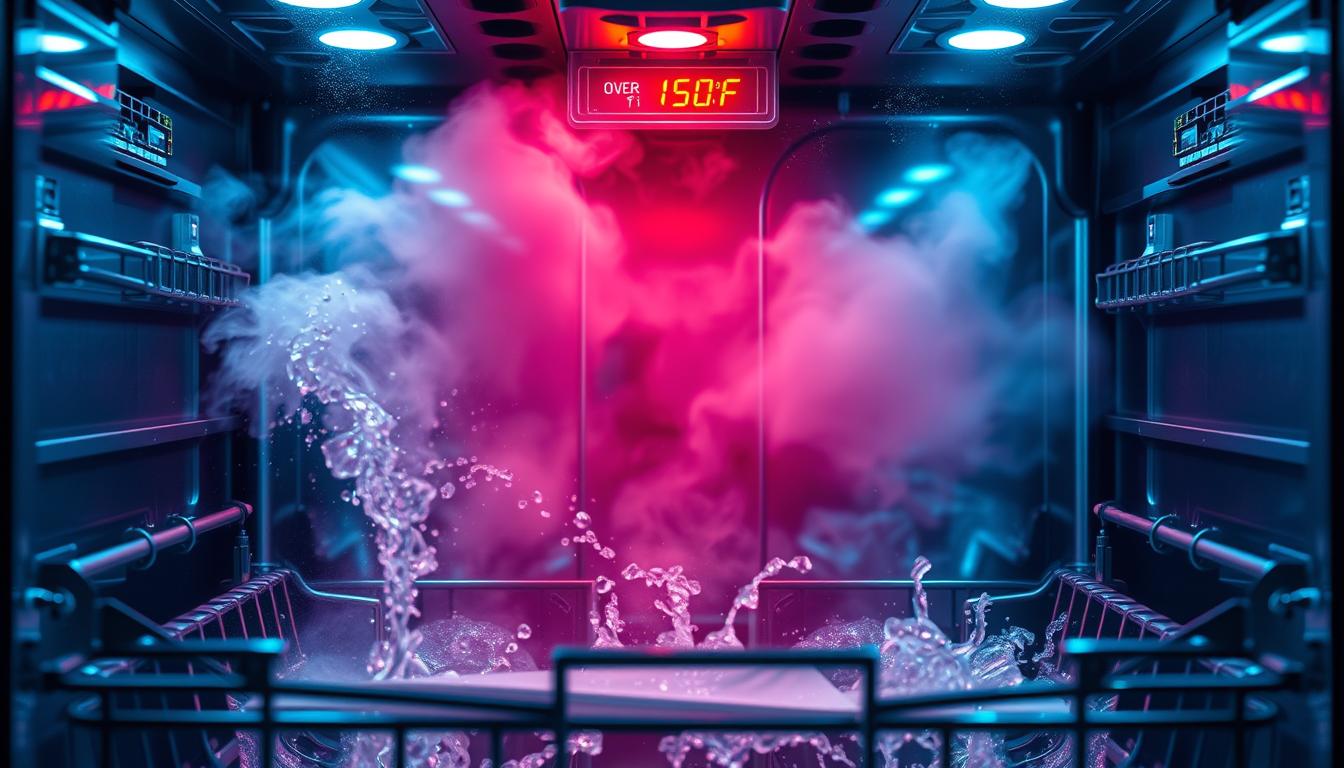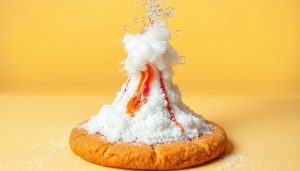Did you know 1 in 3 dishwashers fail to reach the minimum temperature needed to eliminate dangerous bacteria? This oversight leaves millions of households vulnerable to pathogens like Salmonella and E. coli lingering on dishes. Your appliance’s heat settings don’t just clean—they act as a frontline defense against foodborne illnesses.
Just as undercooked food can harbor germs, lukewarm water in your machine allows microbes to survive. Research shows pathogens perish at 149°F (65°C) or higher—a threshold many modern appliances are designed to hit. However, factors like faulty heating elements or short cycles can compromise this critical process.
Your dishwasher’s sanitizing power hinges on maintaining intense heat during both wash and rinse phases. High-temperature water dissolves grease while annihilating microorganisms, transforming everyday cycles into sterilization events. Without this thermal precision, even spotless-looking dishes might host invisible threats.
Key Takeaways
- Heat above 149°F (65°C) is essential for neutralizing harmful pathogens on dishware.
- Sanitization requires sustained high temperatures during multiple cycle phases.
- Inadequate heat exposure parallels the risks of undercooked food preparation.
- Proper temperature maintenance prevents microbial survival on utensils and plates.
- Regular appliance checks ensure consistent thermal performance for safety.
Understanding Dishwasher Temperature Ranges
Not all dishwashers fight germs the same way—some use scorching heat while others deploy powerful chemicals. Your appliance’s approach determines the exact water warmth needed during wash and rinse cycles.

High-Temperature vs. Low-Temperature Models
High-temperature dishwashers eliminate pathogens through intense heat alone. These machines require wash phases between 150-165°F and rinses reaching 165-180°F. Stationary rack units need 165°F during washing, while dual-temperature models operate at 150°F.
Low-temperature dishwashers combine 120°F water with chemical sanitizers. This hybrid method dissolves food residue while activating germ-killing agents. These units often use less energy but depend on detergent quality.
Key Temperature Guidelines for Wash and Rinse Cycles
Check your machine’s data plate to confirm its type and requirements. Conveyor-style units vary: single-tank models need 160°F during the wash cycle, while multi-tank systems use 150°F.
For sanitization, high-temperature dishwashers demand rinse phases of 165°F (single-tank) or 180°F (multi-tank). Chemical-based models maintain safety at lower heats but require precise detergent dosing.
How Temperature Kills Bacteria in Your Dishwasher
At the molecular level, heat disrupts bacterial cells like a wrecking ball. Proteins vital for survival unravel when exposed to intense warmth, while cell membranes melt into useless puddles. This dual destruction makes reproduction impossible and leads to rapid microbial collapse.

Your appliance relies on two thermal weapons: scalding water and sustained exposure. The NSF’s 150°F standard ensures machines disable 99.9% of pathogens during cycles. While residential units can’t achieve medical-grade sterilization (requiring 250°F+), they create hostile environments where germs can’t thrive.
Three key factors determine success: water temperature, detergent activation, and cycle duration. Hot liquid dissolves grease better than cold, exposing hidden bacteria to lethal conditions. Most models peak near 160°F during final rinses—enough to neutralize E. coli and Salmonella through combined thermal and chemical action.
Sanitization differs from sterilization in critical ways. The former reduces microbes to safe levels, while the latter eliminates all life forms. Your dishwasher achieves the first through precise heat management, transforming everyday washes into pathogen purges without risking damage to tableware.
Optimizing Wash and Rinse Cycles for Sanitization
Proper cycle configuration transforms your appliance into a germ-fighting powerhouse. Strategic temperature management during each phase ensures both cleanliness and safety for every load.

Effective Rinse and Sanitizing Temperatures
Your appliance uses a two-phase thermal attack. The main wash cycle operates at 130-140°F – hot enough to dissolve detergent and lift food residue. During the sanitizing rinse, temperatures surge to 180°F, creating lethal conditions for pathogens.
| Cycle Phase | Temperature Range | Primary Function |
|---|---|---|
| Main Wash | 130-140°F | Detergent activation & debris removal |
| Final Rinse | 165-180°F | Pathogen elimination & surface sanitization |
| Drying | 140-160°F | Evaporation & residual heat protection |
The Role of Heating Elements in Cleaning
Your dishwasher’s built-in heater compensates for inadequate home water heating. Located at the tub’s base, this component boosts incoming water by 20-40°F during critical phases. Combined with prolonged exposure times, it ensures dish surfaces reach 160°F – the safety threshold for microbial elimination.
Test strips verify thermal effectiveness. Place one on your top rack during a sanitizing cycle. Successful results show color changes confirming 160°F surface contact. For optimal performance, clean the heating element monthly to prevent mineral buildup.
Adjusting Your Dishwasher for Optimal Heat
Balancing cleaning power with energy efficiency starts with precise temperature control. Most appliances perform best when connected to a hot water supply set between 120°F and 150°F. This range activates detergents effectively while protecting delicate items from heat damage.

Configuring Temperature Settings for Efficiency
Your home’s water heater directly impacts washing results. Set it to 140°F for a balance between sanitization and safety. Water loses 2-5°F traveling through pipes, so account for this drop when choosing settings.
Check your appliance’s manual for adjustable temperature options. Many models offer heavy-duty cycles that boost heat for greasy pans, while gentle modes protect glassware. Match these settings to your load’s soil level for optimal cleaning without wasted energy.
Avoid exceeding 150°F in your water heater. Excessive heat warps plastic containers and degrades rubber seals over time. Test incoming water temperature using a thermometer at the nearest faucet to confirm proper delivery.
For consistent performance, ensure your water heater meets your machine’s gallon-per-minute requirements. Larger households might need tankless systems during peak usage. Regular maintenance prevents sediment buildup that reduces heating efficiency.
Monitoring Water Pressure and Cleaning Mechanisms
Consistent appliance care ensures optimal performance and germ elimination. Three critical elements work together: water flow, mechanical components, and preventive maintenance habits.
Regular Maintenance Tips to Ensure Ideal Performance
Inspect spray arms monthly for mineral buildup or food debris blockages. Soak clogged nozzles in vinegar for 30 minutes to dissolve hard water deposits. Replace worn rotating mechanisms every 2-3 years.
Clean filters weekly using warm soapy water. Check your machine’s manual for removable part locations. Clear scrap trays after each cycle to prevent bacterial growth in trapped particles.
| Maintenance Task | Frequency | Impact on Performance |
|---|---|---|
| Spray arm inspection | Monthly | Prevents 85% of flow issues |
| Filter cleaning | Weekly | Improves water circulation by 40% |
| Scrap tray emptying | Daily | Reduces clogs by 90% |
Ensuring Adequate Water Flow for Effective Cleaning
Verify water pressure using manufacturer-recommended test strips. Low pressure often stems from kinked supply lines or faulty inlet valves. Address issues within 48 hours to prevent persistent cleaning failures.
Position dishes to allow unobstructed rotation of spray arms. Leave 2-3 inches between items for proper water distribution. Overloaded racks reduce cleaning efficiency by 60% according to NSF studies.
Run empty cycles with citric acid monthly to descale internal components. This preserves heating elements and maintains consistent flow rates during wash cycles.
Utilizing the Sanitize Cycle for Thorough Cleaning
Your appliance’s sanitize cycle transforms routine cleaning into microbial defense. This feature elevates water temperatures beyond standard cycles, meeting NSF requirements for eliminating 99.9% of pathogens. When activated, it extends exposure times to ensure surfaces reach critical heat thresholds.
Step-by-Step Guide to Maximum Protection
Load strategically to allow unobstructed water flow. Place plastic items on the top rack and position bowls face-down. Select the sanitize option—usually marked with a medical cross symbol—before starting.
Modern units boost temperatures to 150°F+ during wash phases, holding there for 10+ minutes. Final rinse cycles then use scalding water to lock in results. Always use NSF-certified detergents to complement thermal action.
Post-cycle, leave the door closed for 15 minutes. Residual heat continues disinfecting while drying dishes. For weekly maintenance, run empty sanitize cycles with vinegar to dissolve mineral deposits.
Verify effectiveness using test strips on glassware. Color changes confirm surface temperatures reached germ-killing thresholds. Pair this feature with regular filter cleaning for consistently safe results.



